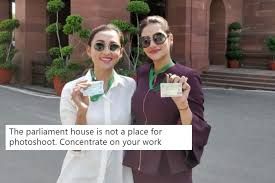Guidelines: What To Wear And What Not To Wear
Jun 04, 2019 • 23 views
Nazar teri buri, burkha mai kya pehenu?
The above statement that roughly translates to, ‘Why should I wear a burkha if it is your vision which is bad’ has been called into question by the poignant fairer sextime and again.
In the wake of the famous 'Gurugram ki Auntiji’ instance, there was a trail of trolls and criticism being targeted at the woman who had made a dismal snide remark at the apparel of the bevy of ladies at a local restaurant. The middle-aged woman unaware of the social drama that would ensue, went on to be recorded on camera as she spitefully ranted her stance at how women who wore ‘choti-choti’ dress did so, only to entice the men around. These words were disgraceful and scandalous and the fact that a woman was asking the men around to rape the girls owing to their dressing sense, was deplorable.

It is not too cumbersome to comprehend the accessible data which reports the acts of violence on women belonging to various age, ethnicity, colour and nationality. Among the possible myriad factors that might attribute in the instigation of an assaulter, not one has to be reported on grounds of ‘disapproved’ dress length or ‘inappropriate’ choice of dress either. Any person listing it as a prominent cause for assaults has a sickening mentality and needs medical assistance or therapeutic counseling. So all in all, it would not be wrong to conclude that, an aggressor is provoked solely and entirely by his retarded instincts and precarious scruples. And if at all, a man is unable to restrain from committing rape everytime he sees a woman in a some item of provocative clothing then he needs to blindfold himself anytime he is in public!
Women are frazzled of this misogynistic rhetoric being incessantly shoved down their throats.
And not just India, this bastion functions even abroad as it renders an unwarranted verdict on a woman’s choice of apparel. Also Celebrities and sports personalities are no exception when it comes to this fashion policing.
Priyanka Chopra, a Padma Shri recipient, and UNICEF Goodwill affronted trolls in 2017 when she was slammed on social media for not being "decently" dressed and sitting in a disrespectful posture at her meeting with Prime Minister Narendra Modi in Berlin.

Serena Williams created quite an uproar at her Wimbledon match against Anastasia Pavlyuchenkova in 2016— surprsingly not because she had aced yet another tournament, rather because … she had nipples, and the people had discovered it. France’s Jo-Wilfried Tsonga also had a visible nipples during the men’s quarterfinals match on Wednesday, as did his opponent, Great Britain’s Andy Murray — but they didn’t garnerthe same overwhelming response that Williams did, much to their disappointment maybe. A twitterati was quick to respond to this hysteria by “Williams isn’t here [to] win a 7th title, or play utterly indomitable tennis. Nah, she’s just ‘flaunting her nipples,’” . And rightly said.

In 2005, when Sania Mirza the tennis ace was issued a Fatwa against owing to the short skirts and revealing tops she wore on the international tennis circuit that ‘left nothing to the imagination’. She was reminded to follow the example of Iranian women who wore long tunics and headscarves to play in the Asian Badminton Championships.
At the 2016 Rio Olympics, the Saudi officials insisted all female competitors of Saudi dress to "preserve their dignity" - hence the modest, long-sleeved garments and hijab covering the hair. In 2018, a 20-year-old Muslim woman, Sarah Iftekhar, was all prepped to become the first beauty queen to participate in the Miss England finals while wearing a hijab. In spite of not being the first Miss England contended to sport a hijab, she was the first to make it to the final stage of the competition.
However, this news wasn’t received well by several, who thought of hijab as regressive and hence representing the conservative mentality we are trying to fight.

Here, at its core lies the struggle: What to laud as liberal and what to dismiss as conservative? And by replying to this, I don’t imply on just one religious segment but on the entirety of the female varsity.
A woman has the right to wear whatever they want to, even hijab if she does so out of the free will. Our conflict against the policing of women’s clothes is on grounds of forcing choices and imposing opinions on them in the name of customs or culture or anything in the likes of it. By blaming toxic male mindset on their clothes, and not on male upbringing and regressive traditions which attribute to a sense of entitlement among men, we are only but promoting this sickening mentality.
One cannot advocate freedom to choose clothes as per their will for women, and then pick on those who opt for conservative clothes. Because that negates the very argument. People need to realize that the women who have spent all their lives living a conservative life, don’t wish to wear a bikini or a short skirt as they feel uncomfortable in it. For them, even the transition from a burka to hijab or pallu over their face to slipping it back to cover just their heads is a radical and bold move

So the same hijab and burkha become an instrument for both patriarchy and our struggle for the right to choose. The key word here is free will.
Liberation has different definitions and implications for every woman out there. After all, freedom from policing of attire is not about the length of the skirt or about wearing salwar kurta and not jeans( the famous Khap verdict for women must be recalled).
It is about having the right to make the choice for oneself.
Just two days ago the Indian Express reported that:
‘A company’s offered extra payments for women who wear a skirt or a dress to work. It has sparked a furious backlash in Russia, with feminists deeming it a replication to the Middle Ages. Aluminium firm Tatprof assured 100 roubles ($1.50)/ day to female staff who sent bosses a selfie of themselves dressed according to rules that also mandatorily asked them to wear modest make-up and have their hair tied up.’
27th May 2019: Two Parliamentarian MP’s of the next-gen leadership fresh, young and dynamic wore something that was ‘unconventional’ to a woman MP. The popular Bengali actresses Nushrat Jahan and Mimi Chakraborty wore pants and tops which did not go down well with a certain section of people who outcried they were not "appropriately dressed" for the Parliament while Gautam Gambhir in a casual t-shirt and pair of denims was given granted a leeway.

One social media user commented: "Parliament is not a photo studio", while another slammed Mimi Chakraborty saying "she is not suitable for the position". All because of the attire change in Parliament where most women lawmakers are seen wearing sarees.
Instances like these point to an impasse. The question at hand shall forever be: ‘ How justified is it to frame the paradigm of an ‘appropriately’ dressed woman and if a woman really needs the certificates of commendation validating her high moral character ?’
The answer from me, is a resounding NO!
What is yours?
